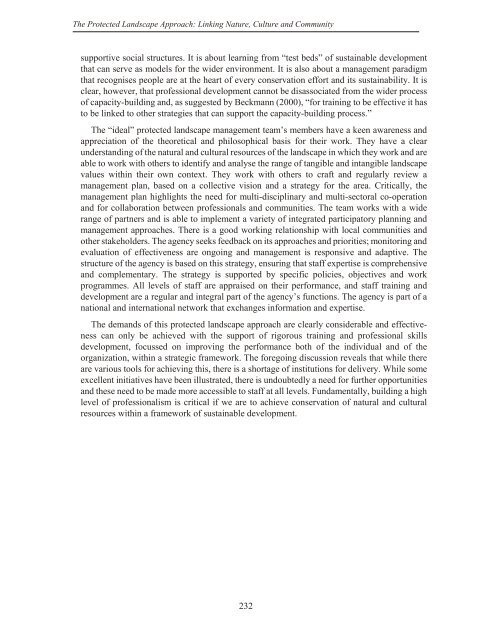The Protected Landscape Approach - Centre for Mediterranean ...
The Protected Landscape Approach - Centre for Mediterranean ...
The Protected Landscape Approach - Centre for Mediterranean ...
Create successful ePaper yourself
Turn your PDF publications into a flip-book with our unique Google optimized e-Paper software.
<strong>The</strong> <strong>Protected</strong> <strong>Landscape</strong> <strong>Approach</strong>: Linking Nature, Culture and Community<br />
supportive social structures. It is about learning from “test beds” of sustainable development<br />
that can serve as models <strong>for</strong> the wider environment. It is also about a management paradigm<br />
that recognises people are at the heart of every conservation ef<strong>for</strong>t and its sustainability. It is<br />
clear, however, that professional development cannot be disassociated from the wider process<br />
of capacity-building and, as suggested by Beckmann (2000), “<strong>for</strong> training to be effective it has<br />
to be linked to other strategies that can support the capacity-building process.”<br />
<strong>The</strong> “ideal” protected landscape management team’s members have a keen awareness and<br />
appreciation of the theoretical and philosophical basis <strong>for</strong> their work. <strong>The</strong>y have a clear<br />
understanding of the natural and cultural resources of the landscape in which they work and are<br />
able to work with others to identify and analyse the range of tangible and intangible landscape<br />
values within their own context. <strong>The</strong>y work with others to craft and regularly review a<br />
management plan, based on a collective vision and a strategy <strong>for</strong> the area. Critically, the<br />
management plan highlights the need <strong>for</strong> multi-disciplinary and multi-sectoral co-operation<br />
and <strong>for</strong> collaboration between professionals and communities. <strong>The</strong> team works with a wide<br />
range of partners and is able to implement a variety of integrated participatory planning and<br />
management approaches. <strong>The</strong>re is a good working relationship with local communities and<br />
other stakeholders. <strong>The</strong> agency seeks feedback on its approaches and priorities; monitoring and<br />
evaluation of effectiveness are ongoing and management is responsive and adaptive. <strong>The</strong><br />
structure of the agency is based on this strategy, ensuring that staff expertise is comprehensive<br />
and complementary. <strong>The</strong> strategy is supported by specific policies, objectives and work<br />
programmes. All levels of staff are appraised on their per<strong>for</strong>mance, and staff training and<br />
development are a regular and integral part of the agency’s functions. <strong>The</strong> agency is part of a<br />
national and international network that exchanges in<strong>for</strong>mation and expertise.<br />
<strong>The</strong> demands of this protected landscape approach are clearly considerable and effective -<br />
ness can only be achieved with the support of rigorous training and professional skills<br />
development, focussed on improving the per<strong>for</strong>mance both of the individual and of the<br />
organization, within a strategic framework. <strong>The</strong> <strong>for</strong>egoing discussion reveals that while there<br />
are various tools <strong>for</strong> achieving this, there is a shortage of institutions <strong>for</strong> delivery. While some<br />
excellent initiatives have been illustrated, there is undoubtedly a need <strong>for</strong> further opportunities<br />
and these need to be made more accessible to staff at all levels. Fundamentally, building a high<br />
level of professionalism is critical if we are to achieve conservation of natural and cultural<br />
resources within a framework of sustainable development.<br />
232

















